2001 VOLVO S80 roof
[x] Cancel search: roofPage 13 of 106
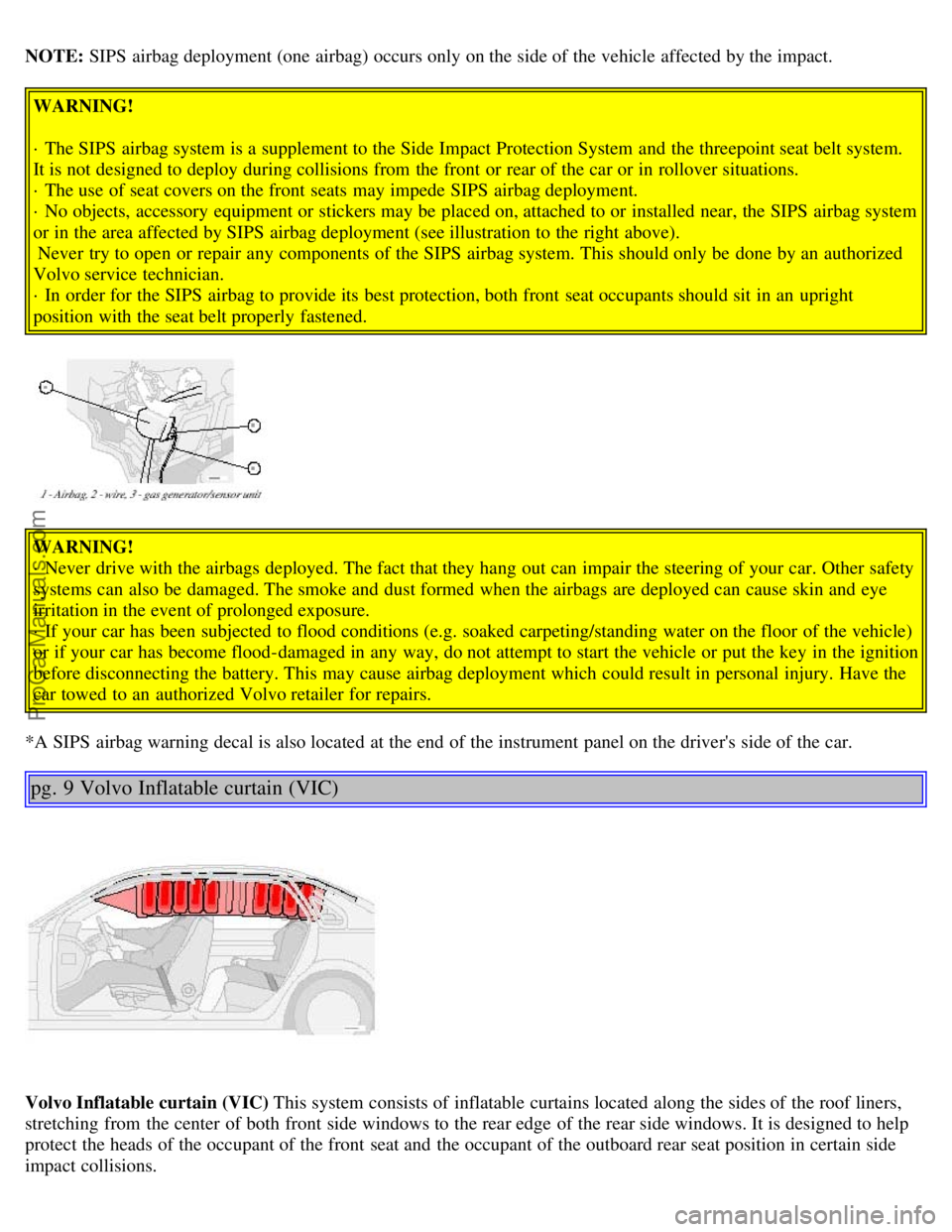
NOTE: SIPS airbag deployment (one airbag) occurs only on the side of the vehicle affected by the impact.
WARNING!
· The SIPS airbag system is a supplement to the Side Impact Protection System and the threepoint seat belt system.
It is not designed to deploy during collisions from the front or rear of the car or in rollover situations.
· The use of seat covers on the front seats may impede SIPS airbag deployment.
· No objects, accessory equipment or stickers may be placed on, attached to or installed near, the SIPS airbag system
or in the area affected by SIPS airbag deployment (see illustration to the right above).
Never try to open or repair any components of the SIPS airbag system. This should only be done by an authorized
Volvo service technician.
· In order for the SIPS airbag to provide its best protection, both front seat occupants should sit in an upright
position with the seat belt properly fastened.
WARNING!
· Never drive with the airbags deployed. The fact that they hang out can impair the steering of your car. Other safety
systems can also be damaged. The smoke and dust formed when the airbags are deployed can cause skin and eye
irritation in the event of prolonged exposure.
· If your car has been subjected to flood conditions (e.g. soaked carpeting/standing water on the floor of the vehicle)
or if your car has become flood-damaged in any way, do not attempt to start the vehicle or put the key in the ignition
before disconnecting the battery. This may cause airbag deployment which could result in personal injury. Have the
car towed to an authorized Volvo retailer for repairs.
*A SIPS airbag warning decal is also located at the end of the instrument panel on the driver's side of the car.
pg. 9 Volvo Inflatable curtain (VIC)
Volvo Inflatable curtain (VIC) This system consists of inflatable curtains located along the sides of the roof liners,
stretching from the center of both front side windows to the rear edge of the rear side windows. It is designed to help
protect the heads of the occupant of the front seat and the occupant of the outboard rear seat position in certain side
impact collisions.
ProCarManuals.com
Page 15 of 106

2 0 0 1
VOLVO S80
Chapter 2 - Instruments, switches and controls
pg. 19 Instruments, switches and controls
Interior20
Exterior21
Instruments22
Instrument panel23
Indicator and warning lights24
Indicator and warning lights24
Text information window26
Switches in center console27
Trip computer28
Cruise control29
Headlights, parking lights, fog lights, instrument illumination30
Turn signals, windshield wipers/washers31
Steering wheel adjustment/lock, ignition switch32
Warning flashers, heated mirrors/rear window/front seats33
Parking brake, auxiliary socket34
Electrically operated windows35
Rearview/sideview/vanity mirrors36
Sun roof37
Sun blinds38
pg. 20 Interior
ProCarManuals.com
Page 17 of 106
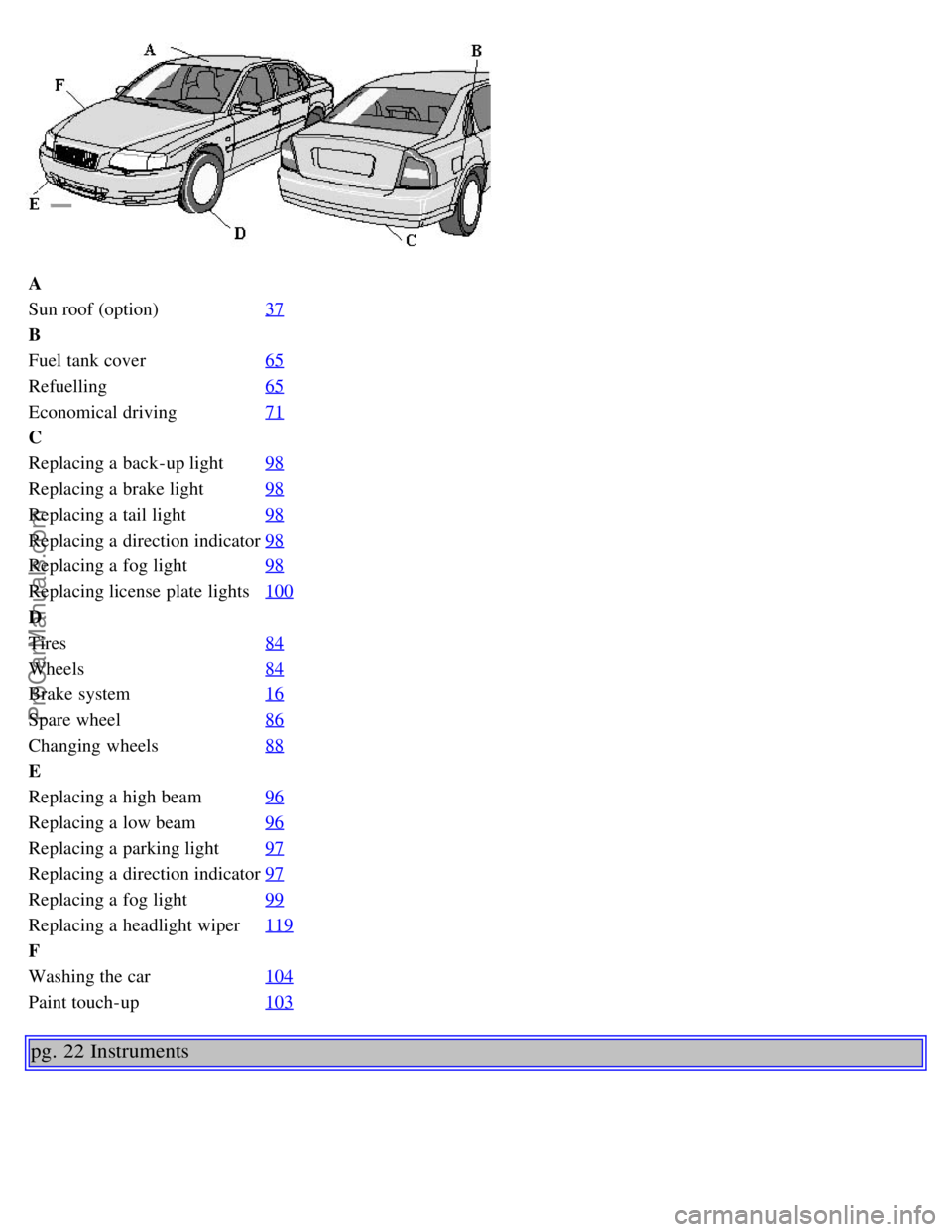
A
Sun roof (option)37
B
Fuel tank cover65
Refuelling65
Economical driving71
C
Replacing a back-up light98
Replacing a brake light98
Replacing a tail light98
Replacing a direction indicator98
Replacing a fog light98
Replacing license plate lights100
D
Tires84
Wheels84
Brake system16
Spare wheel86
Changing wheels88
E
Replacing a high beam96
Replacing a low beam96
Replacing a parking light97
Replacing a direction indicator97
Replacing a fog light99
Replacing a headlight wiper119
F
Washing the car104
Paint touch-up103
pg. 22 Instruments
ProCarManuals.com
Page 28 of 106
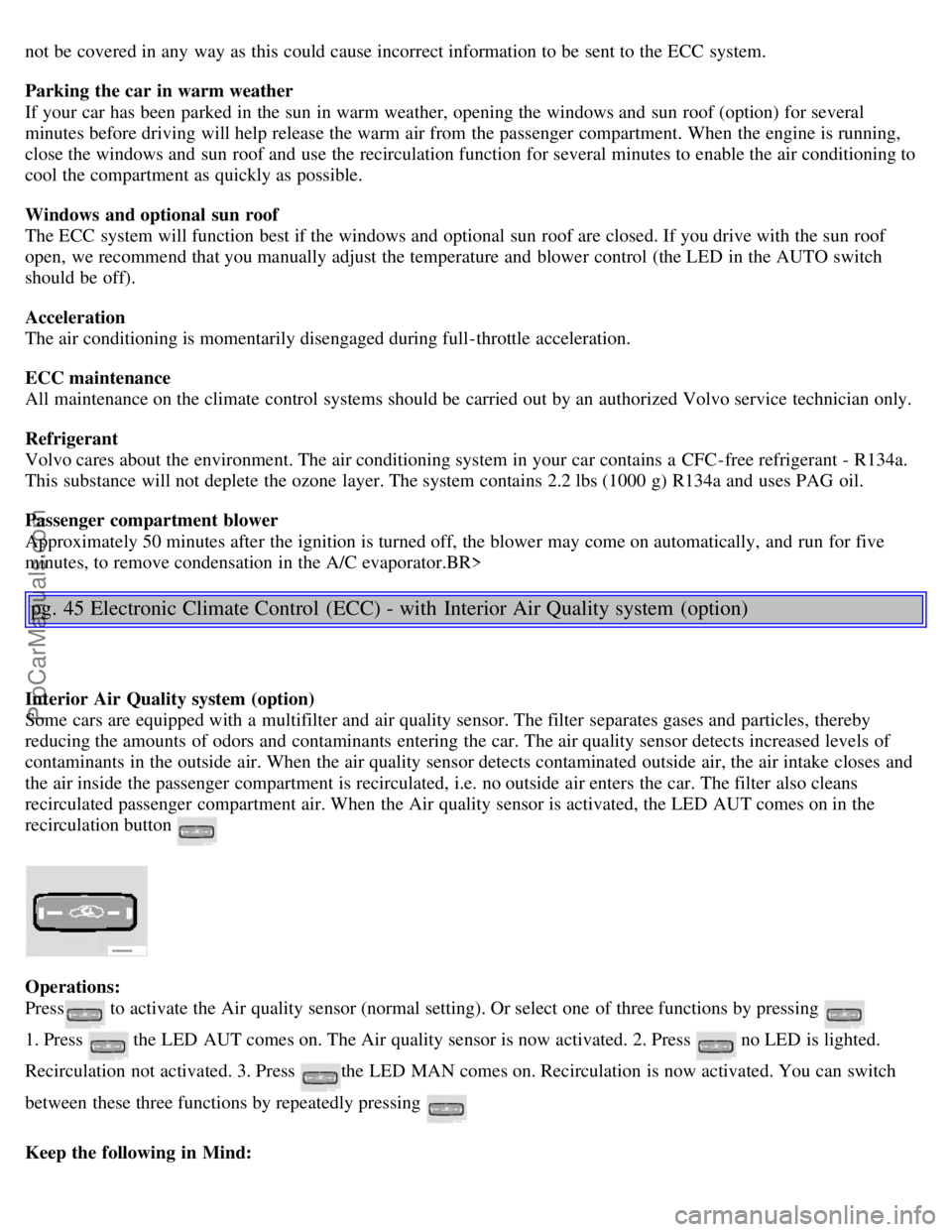
not be covered in any way as this could cause incorrect information to be sent to the ECC system.
Parking the car in warm weather
If your car has been parked in the sun in warm weather, opening the windows and sun roof (option) for several
minutes before driving will help release the warm air from the passenger compartment. When the engine is running,
close the windows and sun roof and use the recirculation function for several minutes to enable the air conditioning to
cool the compartment as quickly as possible.
Windows and optional sun roof
The ECC system will function best if the windows and optional sun roof are closed. If you drive with the sun roof
open, we recommend that you manually adjust the temperature and blower control (the LED in the AUTO switch
should be off).
Acceleration
The air conditioning is momentarily disengaged during full-throttle acceleration.
ECC maintenance
All maintenance on the climate control systems should be carried out by an authorized Volvo service technician only.
Refrigerant
Volvo cares about the environment. The air conditioning system in your car contains a CFC-free refrigerant - R134a.
This substance will not deplete the ozone layer. The system contains 2.2 lbs (1000 g) R134a and uses PAG oil.
Passenger compartment blower
Approximately 50 minutes after the ignition is turned off, the blower may come on automatically, and run for five
minutes, to remove condensation in the A/C evaporator.BR>
pg. 45 Electronic Climate Control (ECC) - with Interior Air Quality system (option)
Interior Air Quality system (option)
Some cars are equipped with a multifilter and air quality sensor. The filter separates gases and particles, thereby
reducing the amounts of odors and contaminants entering the car. The air quality sensor detects increased levels of
contaminants in the outside air. When the air quality sensor detects contaminated outside air, the air intake closes and
the air inside the passenger compartment is recirculated, i.e. no outside air enters the car. The filter also cleans
recirculated passenger compartment air. When the Air quality sensor is activated, the LED AUT comes on in the
recirculation button
Operations:
Press
to activate the Air quality sensor (normal setting). Or select one of three functions by pressing
1. Press
the LED AUT comes on. The Air quality sensor is now activated. 2. Press no LED is lighted.
Recirculation not activated. 3. Press
the LED MAN comes on. Recirculation is now activated. You can switch
between these three functions by repeatedly pressing
Keep the following in Mind:
ProCarManuals.com
Page 42 of 106
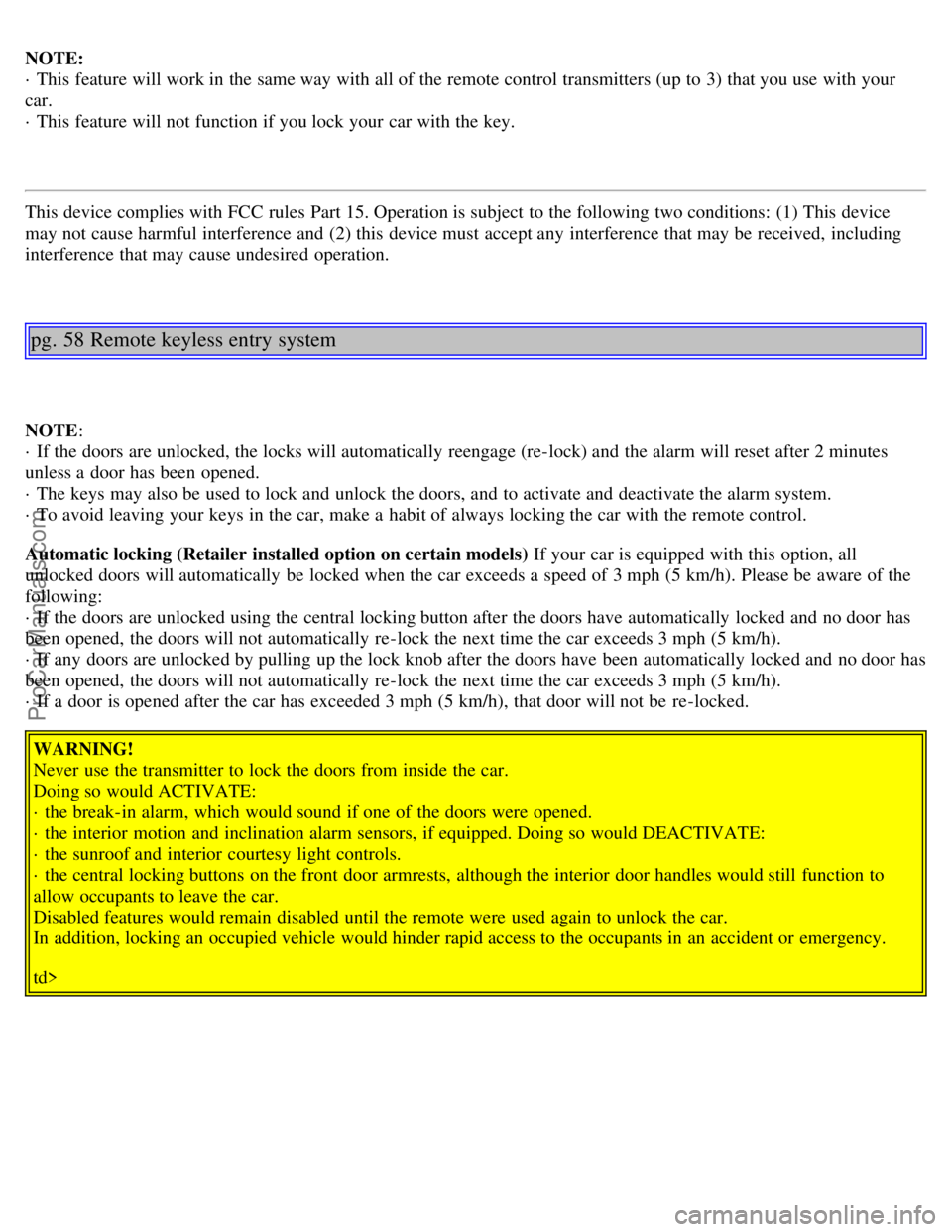
NOTE:
· This feature will work in the same way with all of the remote control transmitters (up to 3) that you use with your
car.
· This feature will not function if you lock your car with the key.
This device complies with FCC rules Part 15. Operation is subject to the following two conditions: (1) This device
may not cause harmful interference and (2) this device must accept any interference that may be received, including
interference that may cause undesired operation.
pg. 58 Remote keyless entry system
NOTE :
· If the doors are unlocked, the locks will automatically reengage (re-lock) and the alarm will reset after 2 minutes
unless a door has been opened.
· The keys may also be used to lock and unlock the doors, and to activate and deactivate the alarm system.
· To avoid leaving your keys in the car, make a habit of always locking the car with the remote control.
Automatic locking (Retailer installed option on certain models) If your car is equipped with this option, all
unlocked doors will automatically be locked when the car exceeds a speed of 3 mph (5 km/h). Please be aware of the
following:
· If the doors are unlocked using the central locking button after the doors have automatically locked and no door has
been opened, the doors will not automatically re-lock the next time the car exceeds 3 mph (5 km/h).
· If any doors are unlocked by pulling up the lock knob after the doors have been automatically locked and no door has
been opened, the doors will not automatically re-lock the next time the car exceeds 3 mph (5 km/h).
· If a door is opened after the car has exceeded 3 mph (5 km/h), that door will not be re-locked.
WARNING!
Never use the transmitter to lock the doors from inside the car.
Doing so would ACTIVATE:
· the break-in alarm, which would sound if one of the doors were opened.
· the interior motion and inclination alarm sensors, if equipped. Doing so would DEACTIVATE:
· the sunroof and interior courtesy light controls.
· the central locking buttons on the front door armrests, although the interior door handles would still function to
allow occupants to leave the car.
Disabled features would remain disabled until the remote were used again to unlock the car.
In addition, locking an occupied vehicle would hinder rapid access to the occupants in an accident or emergency.
td>
ProCarManuals.com
Page 57 of 106
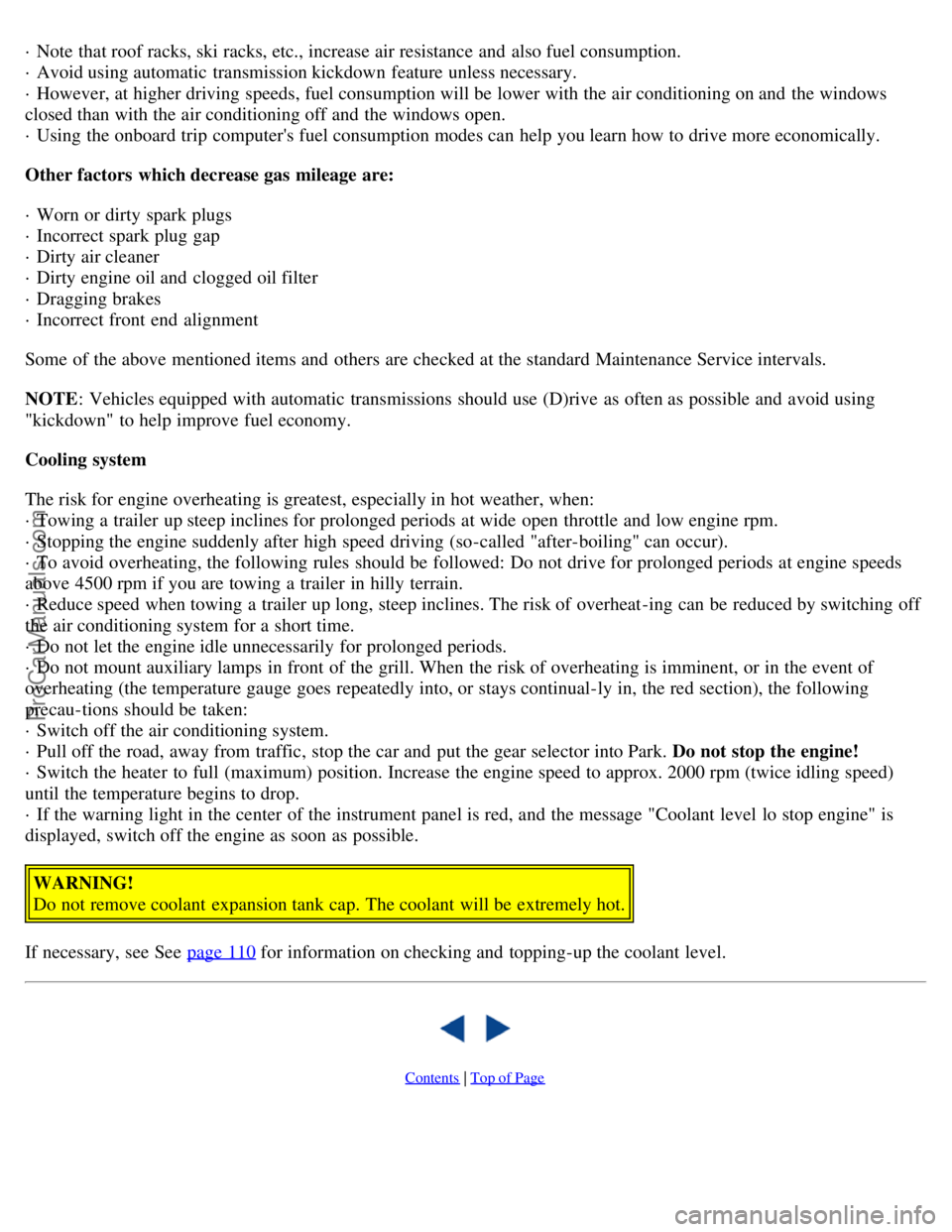
· Note that roof racks, ski racks, etc., increase air resistance and also fuel consumption.
· Avoid using automatic transmission kickdown feature unless necessary.
· However, at higher driving speeds, fuel consumption will be lower with the air conditioning on and the windows
closed than with the air conditioning off and the windows open.
· Using the onboard trip computer's fuel consumption modes can help you learn how to drive more economically.
Other factors which decrease gas mileage are:
· Worn or dirty spark plugs
· Incorrect spark plug gap
· Dirty air cleaner
· Dirty engine oil and clogged oil filter
· Dragging brakes
· Incorrect front end alignment
Some of the above mentioned items and others are checked at the standard Maintenance Service intervals.
NOTE: Vehicles equipped with automatic transmissions should use (D)rive as often as possible and avoid using
"kickdown" to help improve fuel economy.
Cooling system
The risk for engine overheating is greatest, especially in hot weather, when:
· Towing a trailer up steep inclines for prolonged periods at wide open throttle and low engine rpm.
· Stopping the engine suddenly after high speed driving (so-called "after-boiling" can occur).
· To avoid overheating, the following rules should be followed: Do not drive for prolonged periods at engine speeds
above 4500 rpm if you are towing a trailer in hilly terrain.
· Reduce speed when towing a trailer up long, steep inclines. The risk of overheat -ing can be reduced by switching off
the air conditioning system for a short time.
· Do not let the engine idle unnecessarily for prolonged periods.
· Do not mount auxiliary lamps in front of the grill. When the risk of overheating is imminent, or in the event of
overheating (the temperature gauge goes repeatedly into, or stays continual-ly in, the red section), the following
precau-tions should be taken:
· Switch off the air conditioning system.
· Pull off the road, away from traffic, stop the car and put the gear selector into Park. Do not stop the engine!
· Switch the heater to full (maximum) position. Increase the engine speed to approx. 2000 rpm (twice idling speed)
until the temperature begins to drop.
· If the warning light in the center of the instrument panel is red, and the message "Coolant level lo stop engine" is
displayed, switch off the engine as soon as possible.
WARNING!
Do not remove coolant expansion tank cap. The coolant will be extremely hot.
If necessary, see See page 110
for information on checking and topping-up the coolant level.
Contents | Top of Page
ProCarManuals.com
Page 70 of 106

25Ignition switch, Relay starter motor 10A
26Control module - climate control blower 30A
27 Central locking system, power windows, defroster, lighting, sideview mirrors,
door warning lights, power sideview mirrors 15A
28 Power sun roof, courtesy lights, vanity mirror lights 10A
29 Telephone (option) 10A
30 Left front/rear parking lights 10A
31 Right front/rear parking lights, license plate lights 10A
32 Central electrical module, vanity mirror lighting, interior courtesy lights,
power steering 10A
33 Fuel pump 15A
34 Power sun roof 15A
35 Central locking system, power windows - left front 25A
36 Defroster, Lighting, Sideview mirrors, central locking system, power windows - right front 25A
37 Power windows - rear doors, child safety locks 30A
38 Siren alarm 5A
pg.95 Fuses in the trunk
Fuses in the trunk
The fuses in the trunk are located behind the left panel. When replacing a blown fuse, be sure to replace it with a new
one of the same color and amperage (written on the fuse).
Ordinary fuses
Location Amperage
1 Rear electrical module, trunk lights 10A
2 Rear fog light 10A
3 Brake lights 15A
4 Backup lights 10A
5 Rear window heater 5A
ProCarManuals.com
Page 80 of 106

6 cyl.890 lbs (400 kg) 400 kg
6 cyl. turbo890 lbs (400 kg) 400 kg
Curb weight
6 cyl. 3585-3620 Ibs (1626-1642 kg) 1625-1640 kg
6 cyl. turbo 3655-3685 Ibs (1658-1671 kg) 1655-1675 kg
Permissible axle weight, front
6 cyl. 2491 Ibs (1129 kg) 1130 kg
Permissible axle weight, rear
6 cyl. 2293 lbs (1039 kg) 1040 kg
Max roof load 220 lbs (100 kg) 100 kg
Max trailer weight
(w/o brakes) 1100 lbs (500 kg) 500 kg
Max trailer weight
(with brakes)
2" ball 3300 lbs (1500 kg) 1500 kg
1 7/8" ball 2000 lbs (908 kg) 900 kg
Max tongue weight **165 lbs (75 kg) 75 kg
WARNING!
When adding accessories, equipment, luggage and other cargo to your vehicle, the total loaded weight capacity of
the vehicle must not be exceeded.
* The max permissible axle loads or the gross vehicle weight must not be exceeded.
** See also section "Trailer towing"
All specifications are subject to change without prior notice.
pg.124 Engine/transmission specifications
Engine specifications Designation: Volvo B 6284 T
Output 268 hp at 5400 rpm (200 KW/90 rps)
Max torque 280 ft. lbs. at 2100-5000 rpm (380 Nm at 35-83 rps)
Number of cylinders 6
Bore 3.19" (81 mm)
Stroke 3.54" (90 mm)
Displacement 2.78 liters
Compression ratio 8.5:1
Number of valves 24
Charge air cooler (Intercooler)
Turbocharged engines employ a turbocompressor to force air into the engine inlet manifold and a charge air cooler to
ProCarManuals.com